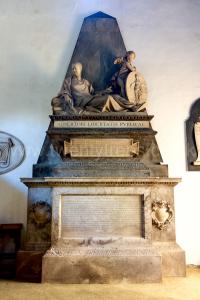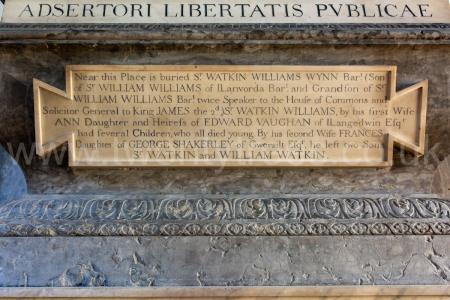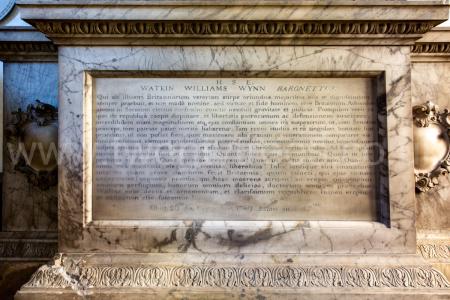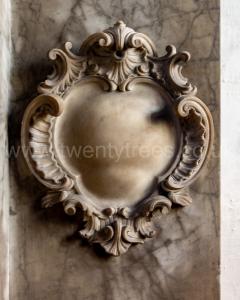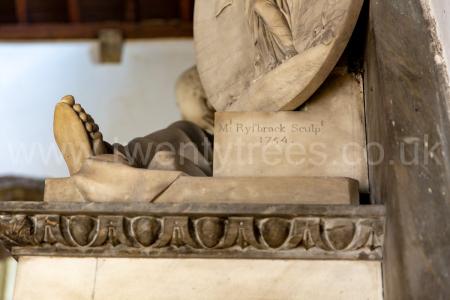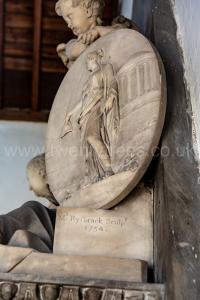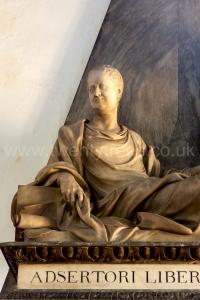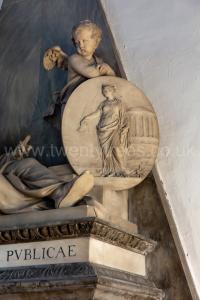Europe, British Isles, North East Wales, Denbighshire, Ruabon, St Mary's Church [Map]
St Mary's Church, Ruabon is in Ruabon.
Exerior of St Mary's Church, Ruabon [Map].
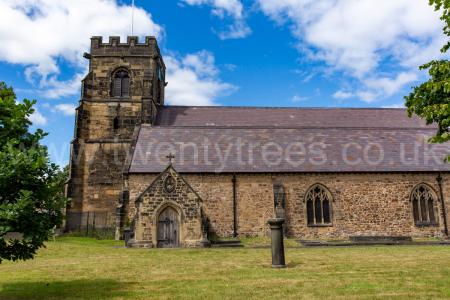
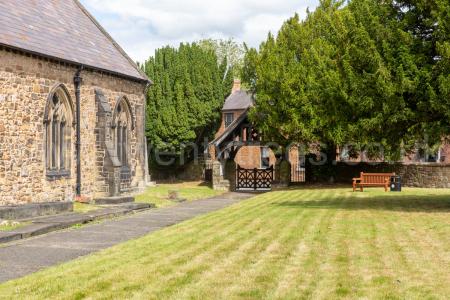
1258. The church in Ruabon [Map] was first mentioned in 1258, when it was dedicated to St Collen. Some medieval fabric still survives, including the fourteenth century western tower, which has perpendicular features, and the arched western door, also of the fourteenth century. A south-eastern chapel was built in 1755 and a north-eastern in 1769.
The church tower dates from the fourteenth century and is a Cheshire-type construction.
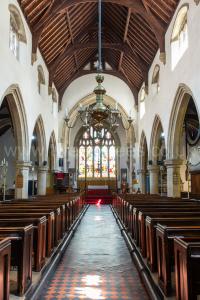
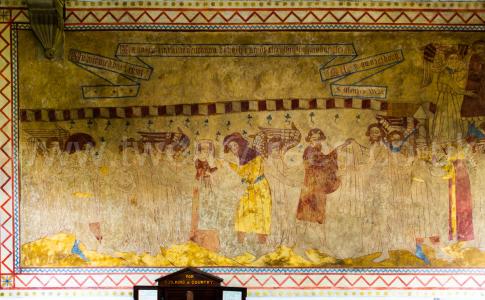
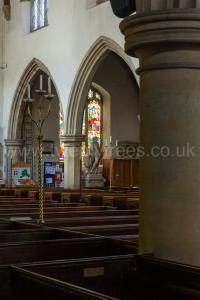
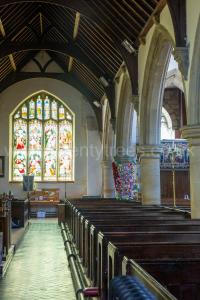
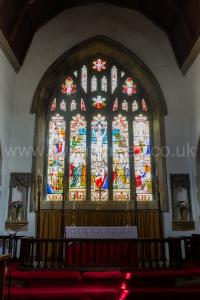
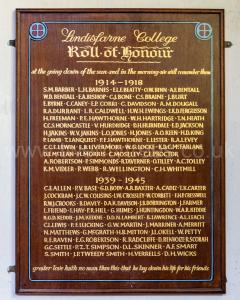
In or after 1526. St Mary's Church, Ruabon [Map]. Monument [Map] to John ap Ellis Eyton. Alabaster Monument. Lancastrian Esses Collar. Possibly Harpur and Moorecock of Burton on Trent.
John ap Ellis Eyton: In 1526 he died.
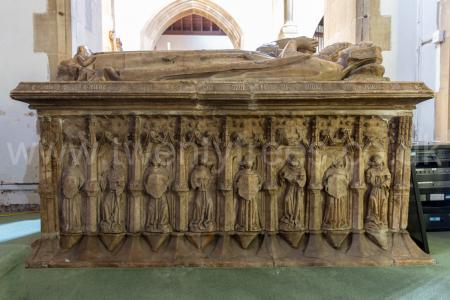
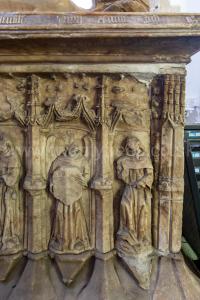 Chest with Angels with Rounded Wings holding Shields indicative of Harpur and Moorecock of Burton on Trent.
Chest with Angels with Rounded Wings holding Shields indicative of Harpur and Moorecock of Burton on Trent.
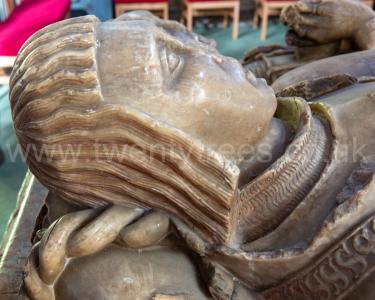 Detail of his head. Categorised as Fluted Period. Note the absence of headwear, his being clean shaven and the Standard protecting the neck all of which define the Fluted Period.
Detail of his head. Categorised as Fluted Period. Note the absence of headwear, his being clean shaven and the Standard protecting the neck all of which define the Fluted Period.
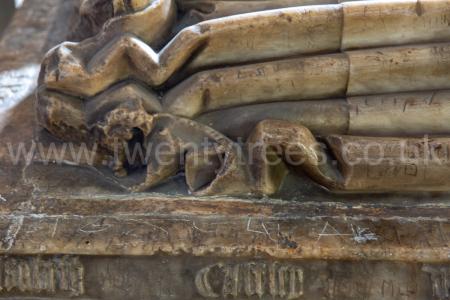 Before it was damaged this was a dog chewing at the hem of her dress; also indicative of Harpur and Moorecock of Burton on Trent.
Before it was damaged this was a dog chewing at the hem of her dress; also indicative of Harpur and Moorecock of Burton on Trent.
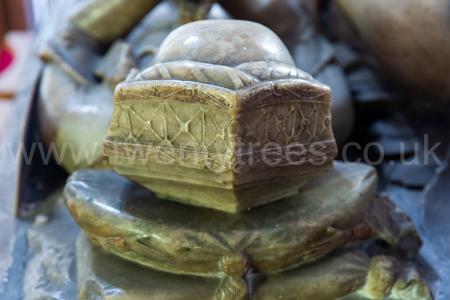
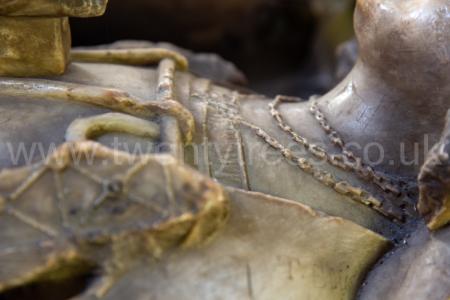
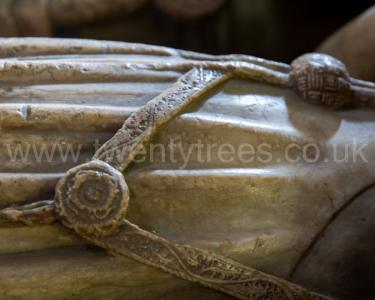
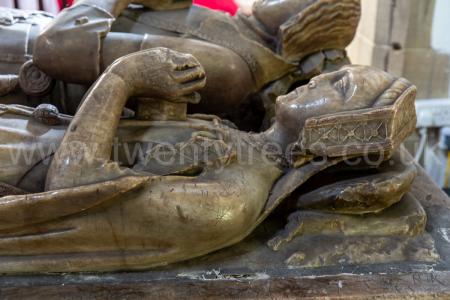 She wearing a Gabled Headress.
She wearing a Gabled Headress.
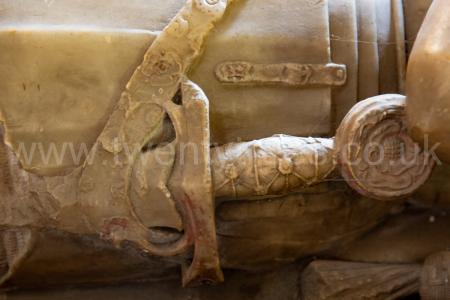 Tudor Roses on his sword pommel.
Tudor Roses on his sword pommel.
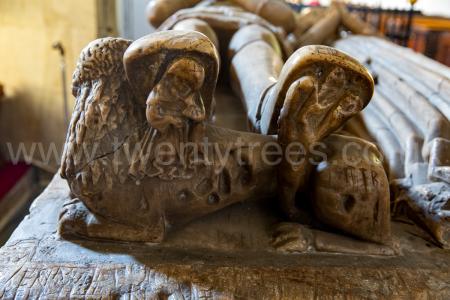 Bedesman and Swirling Tail both indicative of Harpur and Moorecock of Burton on Trent.
Bedesman and Swirling Tail both indicative of Harpur and Moorecock of Burton on Trent.
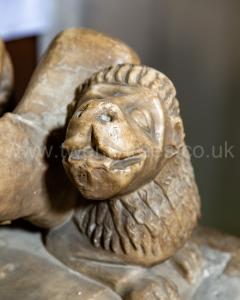 A curious lion at his feet. Unlikely the carver had ever seen a lion.
A curious lion at his feet. Unlikely the carver had ever seen a lion.
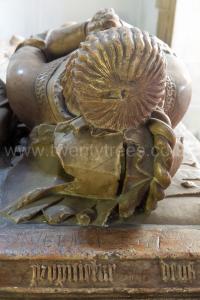
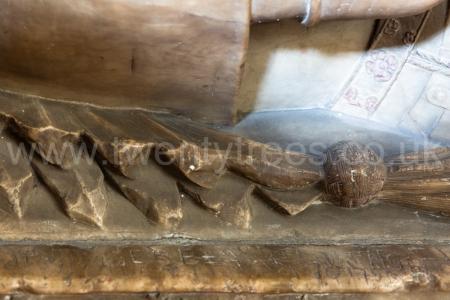
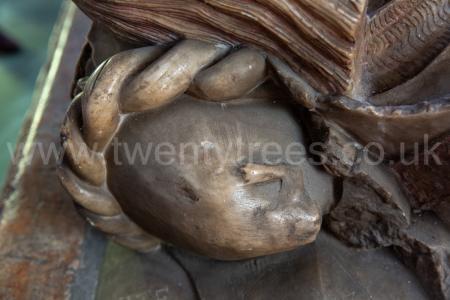 Detail of the orle, mantling and what remains of the crest on his Great Helm. Difficult to tell what it was originally.
Detail of the orle, mantling and what remains of the crest on his Great Helm. Difficult to tell what it was originally.
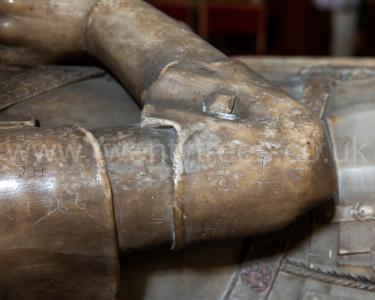
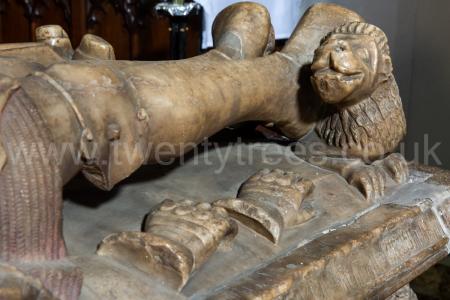
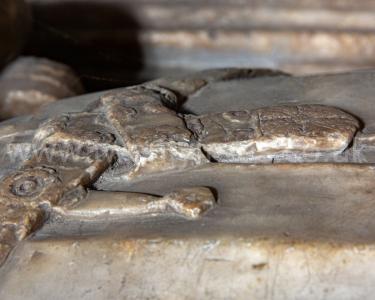
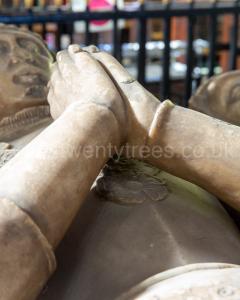
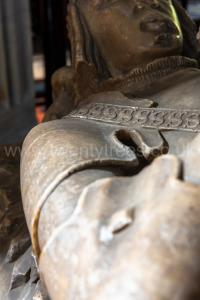
The Cambrian News and Merionethshire Standard. 29 Aug 1884. The marriage of Miss Louise Alexandra Williams Wynn (age 19), eldest and only surviving child of Sir Watkin (age 64) and Lady Williams Wynn, of Wynnstay, with her cousin, Mr Herbert Lloyd Watkin Williams Wynn (age 24), eldest surviving son of the late Colonel Williams Wynn, of Cefn, St. Asaph, and heir presumptive to the baronetcy and estates of Wynnstay, was celebrated on Tuesday, August the 26th, at the parish Church of Ruabon [Map], in the presence of a circle of distinguished friends and relatives, and a large number of neighbours and well-wishers. The bride was born on the 21st of December, 1864, and on the 30th of January, 1865, she was christined by the names already given, having for her sponsors the Queen of Denmark (age 66), the Princess of Wales (age 17), and her uncle, Sir Hugh Williams, Bart., of Bodelwyddan. The bridegroom, who was born on the 6th of June, 1860, is the second, but eldest surviving, son of Sir Watkin's only brother, Colonel Herbert Watkin Williams Wynn, who married Anna (age 50), daughter and heiress of Mr Edward Lloyd, of Cefn, and died in 1862.
The wedding day broke with a chill wind and a leaden grey sky, but the clouds having discharged a few drops of rain about eleven o'clock in the morning, the sky put on a more pleasing appearance, and the sun pepeed out from behind the clouds.
In the Ruabon district extensive preparations were made to fittingly celebrate the auspicious occasion. Each train was laden with passengers, and by ten o'clock nearly 12,000 persons had gathered in the "streets converging on the church and at points from which it was possible to get a glimpse of the bridal procession. It was with some difficulty that a large body of county constabulary kept open a way for the wedding carriages to reach the church. Admission to the church where the ceremony was to take place was only gained by ticket, and long before the time fixed for the arrival of the wedding party the building was tilled in every part by a congregation including most of the gentry and landowners of the surrounding districts.
In Ruabon itself the day was observed as a general holiday, and the streets of the town were decorated with flags, flowers, and evergreens. The railway.station was most profusely decorated with bunt- ing and streamers, which were effectively arranged to span the railway. Immediately outside the station the trees and the housetops were relieved with bannerets, with here and there a motto conveying good wishes to the hero and heroine of the day, or to the family of Wynnstay. At eight in the morning the bells of the parish church were set ringing, and the echoes were awakened by the periodical firing of anvils. The decorative efforts of the Ruabon committee were principally concentrated upon the length of road con- necting the main entrance to Wynnstay Park with the parish church. The most prominent object was a triple arch of noble dimensions, which spanned the rOå trom the Uourt Mouse to the W ynnstay Arms. "The framework of the arch, the walls of which were about two yards in width, was filled with flowering heather, the upper portion of the arch being similarly billed with laurel. Upon ground work were displayed on excellent relief, designs representative of the spread eagle and the cross foxes worked in coloured flowers by Messrs James Dickson, of Chester. On the Wynn- atay side of the main archway spanning the roadway was the following inscription in white on a scarlet ground, Hir oes a phob gwynfyd i ferch Syr Watkin a'i phriod over the smaller subsidiary arches on the same side were the mottoes, "May happiness be theirs" and "God bless the happy pair." On the other side of the arch, and facing the church on the main archway was the inscription, 11 Mng life, health, and happiness to Mr and Mrs H. Ll. Watkin Williams Wynn;" on the smaller arches the mottoes, "Ni ddeil yr eryr ednogyn, pob edn edwyn ei gymmar (The eagle catcheth not at a fly; every winged fowl knows its mate) and Cadarnach yw'r edau yn gyrfodedd nag yn ungor" (Stronger is the thread twisted than single). The summits of the arches were effectively relieved by large banners which floated from them. The Wynnstay Arms, close by, was also most effectively decked with evergreens and bannerets, and leading from the massive arch just described to the park entrance was an avenue of firs. The walls of the cottages on each side of the road were festooned with garlands of evergreens relieved with bunting, and the old stones of the arch leading into the park were almost lost in evergreens. Along the top of the arch ran the words, "God bless the bride and bridegroom.
As the hour for the service approached, the crowd which thronged the space between the park gates and the church grew momentarily larger until as the bridal guests began to arrive with increasing rapidity, the police were scarcely able to secure a passage for them. Long before the hour of ten the place was crowded, and about that hour the Crewe Steam Shed Band arrived, and commenced playing in front of the Court House. Shortly afterwards the local volunteers, led by the Wrexham volunteer band, marched up and joined in lines on each side of the path leading from the church gates to the church door. Placed alter- nately with the red-coated volunteers were maidens from the bride's school, dressed in white. and each carrying a basket of flowers. The bridegroom, who was accompanied by his brother, passed almost un- recognised through the throng on his way to the church, but when Sir Watkin drove up, accompanied by Lord Combermere, he was received with hearty applause, which followed him to the church gates. All the guests having entered the church, all eyes were turned in the direction in which the bride would come, and a few minutes after eleven, the waiting crowd were rewarded by seeing her carriage followed by a crowd coming down the fine avenue leading from the mansion. As the carriage emerged from the park the crowd set up a cheer which was taken up and passed along the ranks as the bride approached the church gates, whence she walked along the scarlet carpeted pathway into the church.
The interior of the sacred edifice was beautifully decorated. festoons of evergreens, with long pendant ten- drils of ivy, hanging from the roof. Within the chan- cel the walls were lined with moss, artistically contrasted with white asters in lover's knot devices, dahlias, gladiolii, and immortelles. On the communion table was a fine altar cloth, the gift of the father of the bride (age 64), and then used for the first time.
The bridegroom entered the church at about a quarter to eleven, accompanied by his brother (Mr Robert Williams Wynn), the best man. Sir Watkin Williams Wynn was shortly afterwards conveyed into the sacred building in his bath chair, being still unable to walk. Then followed the guests staying at Wynnstay (who drove down in carriages), including the Earl of Powis (age 65), Mr T. Tyrwhitt Drake, Mr W. R.M. Wynne, Peniarth, Colonel Wynn Pinch, Countess M. and Countess Helen Bismarck, Lady Mary Herbert, Count Ulottlie, Major and Mrs Rowley, Conwig, Viscount Combermere, Mrs Williams Wynn (age 50) (of Cefn, mother of the bridgegroom), Mr and Mrs Bennett, Mrs Godsall and Mr H. Godsall, the Rev J. S, Raymond, Mr Charles and Lady Amora Williams Wynn, Miss Amora Williams Wynn, Mr and Mrs Bertie Williams Wynn, General Brownrigg, Major Fife, Admiral Somerset, Sir Theodore Martin, Sir Edward and Lady Hamilton, Mr Archibald and Lady Peal, Col. Meredith, Captain Wynn Griffiths, Mrs and Mrs Owen-Slaney Wynne, Plasnewydd, Canon Richardson, and Mr Fitz Hugh.
The bride arrived shortly after eleven o'clock, accompanied by her mother, and walked down the aisle upon the arm of her cousin, Sir W. W. Greville Williams Wynn, Bart., and accompanied by her bridesmaids. She wore an ivory white satin petticoat, covered with old Venetian rose-point lace. The bodice and train were made of terry velvet, trimmed with lace. She had a tulle veil fastened over a wreath of blossoms with pearl and diamond star, the gift of the bridegroom. Her pocket-handkerchicf was of point lace. The bridesmaids were-Miss Helen Williams of Cefn, and Lady Margaret Byng, Miss Edwards, Vicarage, Ruabon, Miss Rowley Conwy, Miss Hampton Lewis. Miss Constance Williams Wynn, Coedymaen Miss Herbert, Styche, Miss C. Brownrigg, Miss Peel, Brynprys, Miss Leighton, Sweeney. They wore white India dresses trimmed with Valenciennes lace, and loops of pale blue ribbon, blue crepe bonnets and aigrettes of feathers to match. Each bridesmaid carried a bouquet of pink roses, and wore a gold bangle, fastened with cross foxes in gold, the gift of the bride-groom. Lady Williams Wynn's dress was of rich antique silver grey velvet brocade, trimmed with old Mechlin lace. She wore a grey bonnet, with feathers to match, and carried a white lace parasol.
The offiiciating clergy were the Rev Watkin Herbert Williams Wynn, cousin of the bride and rector of Bodelwyddan; the Rev E. W. Edwards, vicar of Ruabon the Rev Trevor Owen, vicar of Llangedwyn the Rev Thomas Jones, and the Rev J. B. Armstrong.
As the bride passed up the church the strains of the stately "March of the Priests," from "Athalie," played by the organist, Mr W. Hall, at the request of Lady Williams VVynn, sounded through the church. The marriage ceremony was then proceeded with by the Rev Watkin Williams. The bride was given away by her father Sir Watkin Williams Wynn (age 64). The bride and bridegroom responded in rather low but distinct tones of voice in the all-important part of the service which made them man and wife. The service, though of a simple character, was none the less impressive. No hymn was sung, but the 67th Psalm, "God be merciful unto us and bless us," was chanted by the choir. The latter part of the service was read by the Rev E. W. Edwards, and the final declaration of the duties of man and wife by the Rev R, T. Owen. The ceremony having been brought to a close, the bridal party proceeded to the Wynnstay chapel, to sign the marriage register. While this was being done wedding favours were distributed to the guests, and the bride and the bridegroom received the customary congratulations. Mendelssohn's wedding march was effectively played by the organist at the close of the ceremony, and as the newly-married pair left the church, they were greeted with the heartiest acclamations. It was a pretty sight to see the children strewing their path with flowers, while the church bells pealed forth merrily.
Subsequently the wedding party returned to Wynnstay, where the breakfast was served in the large hall, and presented a scene of great brilliance. A large number of guests were invited, including Mr and Mrs Osborne Morgan, who, however, were prevented from attending by domestic bereavement.
After breakfast, Sir WATKIN proposed the toast of "Her Majesty the Queen, and of the Prince and Princess of Wales and the rest of the Royal Family." In doing so he referred to the fact that the Princess of Wales, whom they all loved and adored, was his dear daughter's godmother. (Cheers.)
The Earl of Powis, in proposing the health of The Bride and Bridegroom," said-A marriage in an ancient family is an event which appeals to our imagination in a very special manner, and this holds good, not merely amongst those who form an intimate family circle, who are connected by ties of relationship and friendship with the bride and bridegroom but extends itself to a 4arge surrounding neighbourhood, to whom the annals of a great house form part of their local traditions. The district to which I apply the term "neighbourhood" includes four counties oi inortn HaleS, anu gue23 uver the Shropshire borders. Flags are flying in the breeze, bells are pealing, town and country are gathered to- gether to celebrate a union which will be memorable in the annals of the Cymry, and form an epoch and period in our lives. (Cheers.) There is no country in which local traditions and ancient memories are so jealously re- vered and guarded as in Cambria. (Cheers.) Our family pedigrees, which go back for many years to a long and ancestral past, keep alive the memory and the names of those who have gone before, till family history mingles itself insensibly with legendaty lore. The young couple upon whom attentions and marks of regard have been lavished will soon see how universal is the feeling which is inspired towards their parents by the manner in which throughout their life they have discharged the various duties of their position. (Loud cheers.) The parents will appreciate the sincerity of the good- will which knows that the affection and sympathy shewn to the new generation is the most grateful and most sincere homage that can be rendered to the old. (Cheers.) I will now give you, ladies and gentlemen, full scope to those feelings of sympathy and seatiment which this occasion and this assembly inspire in all our breasts. I will ask you to joiu with me in all sincerity and truth, in wishing long life and happi- ness to Herbert and Louise Williams Wynn. (Loud cheers.)
Mr W. R. M. W YNNE, of Peniarth, then briefly proposed the toast in Welsh, and it was received with the greatest enthusiasm. greatest enthusiasm.
The BRIDEGROOM, who on rising was received with loud cheers, said-I beg to thank you on behalf of Mrs Williams Wynn and myself most sincerely for the kind way in which you have drunk our health. I can only say that we both feel very much more the kind- ness of the way in which you have received us than we cau ever express in words. I beg to thank you. (Loud cheers.)
Count MOLTKE proposed the health of Sir Watkin and Lady Williams Wynn, which was drunk with great enthusiasm.
Sir WATKIN, in reply, said:-On behalf of Lady Williams Wynn and myself, I beg to thank you for the kindness shown to us, aud our dear girl. I hope and trust that her marriage, so auspiciously celebrated to-day, may bring the happiness that we all wish for them. (Cheers.) I believe that a marriage in this house has not been celebrated in Ruabon Church since before this century was in its teens. Those who were then married have, unfortunately, passed away, but I am happy to say that the grandchildren and great grandchild of that branch of the family are here to-day. I am glad that we have with us to day Sir Edward Hanmer and Lord Combermere, my old friend and fellow-collegian and another friend, who married us thirty-two years ago, I am also happy to see present on this occasion. I beg again to thank you for your very great kindness towards us and my dear daughter and for your presence here to-day, (Cheers.)
Colonel WYNNE FINCH proposed the toast of the bridesmaids, which was very heartily received, and responded to by Mr ROBERT WILLIAMS WYNN. The wedding cakes were on view at the Wrexham Savings Bank during Wednesday and Thursday, and Mr Stephens, the purveyor, was highly complimented on his work, Lady Williams Wynn calling on Thurs- day and expressing great satisfaction. The total weight of the cakes is over 1,800lbs. They were placed on a.blue ground, surrounded by a number of choice ferns and plants with variegated foliage. In the centre was placed the Wynnstay cake. the first tier of which was decorated with horse shoe shales, bearing the monograms of the bride and bridegroom, and the other tiers were supported by draped figures and festooned in a pretty manner. Sur- mounting all was a miniature temple, in the centre of which was a playing fountain of exquisite design and workmanship. The other cakes were equally beautiful, the decoration representing rich clusters of the vine and emblematic flowers, while the heads of hounds looking out from the foliage gave it a sportive aspect in keeping with the re- nown of Wynnstay. The mottoes on the bannerettes that decked the cakes were in Welsh. The wedding cakes are sent to Machynlleth, Llanuwchllyn, Bala, Llangedwyn, Oswestry, Ruabon, Llangurig, Traws- fynydd, Llangollen, Llwydiarth, Llansilin, Llanfyllin, Llanbrynmair, Wrexham, Ruthin, Llanrhaiadr, Llan- armon D. C., Llangadfan (including Cwm, Cann Office, Gartheibio, Llanerfyl, and Llanfair), Llanwddyn, and Rhydycroesau.
About three o'clock the bride and bridegroom left Wynnstay for Llangedwyn, and the guests and house- hold assembled to offer their congratulations, and to pelt them with rice and old slippers. The bride's travelling dress was of sapphire blue Bengaline, trimmed with velvet. The bodice was of blue velvet, trimmed with old point d'Alencon lace. Her bonnet was of blue crepe and velvet, with feathers to match. Their journey of about twenty miles to Llangedwyn was something like a Royal progress. Crowds assem- bled in many places along the route to see and cheer them. Triumphal arches were erected, and everywhere flags were flying, and devices with numberless good wishes expressed in the form of mottoes were ex-, hibited. They reached Chirk about four o'clock in bright sunshine. An address was read on behalf of the villagers by the Rev Wynne Jones, and another popular demonstration was made at Gobowen, while at Oswestry, which was gaily decorated, a procession was formed of nearly 4,000 school child- ren and their friends, and, being afterwards joined by the Mayor and Corporation, and the members of the various friendly societies, met Mr and Mrs Wynn, and drew their carriage through the town, and finally presented them with an elaborate address from 300 subscribers.
The road to Llangedwyn displayed many signs of the interest felt by the residents in the young couple. At many points on the way they received hearty greetings, but probably the heartiest greetings of the day were those with which they were received by the people of Llangedwyn, who, with Welsh ardour, were not content to await the coming of the bridge and bridegroom, but met them about a mile before they reached the village. The point of meeting was at a very pretty arch erected across the road on the Os- westry side of Abecynlleth, and there the pair of horses were unharnessed, and the conduct of the carriage was committed into the hands of a host of willing substitututes. Led by the Llanrhaiadr Brass Band, the escort, which was of enormous proportions, and most enthu- siastic in character, proceeded to Llangedwyn Hall, passing under several exceedingly effective arches, where a considerable number of ladies and gentlemen, as well as of school children, had assembled to greet the bridal pair. On ascending the steps leading to the terrace, Mr and Mrs William Wynn received three addresses. The first was from the tenants on the Llangedwyn estate, the second from Llanwyddyn, and the third from the Llangedwyn Friendly Society, all of which were suitably acknowledged by Mr Williams Wynn.
After 1915. War Memorial at St Mary's Church, Ruabon [Map].
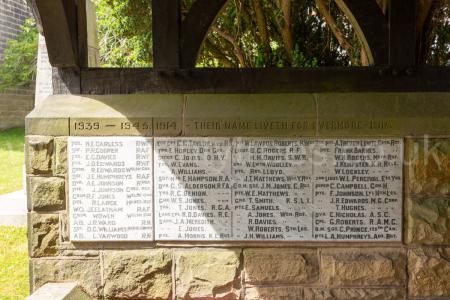
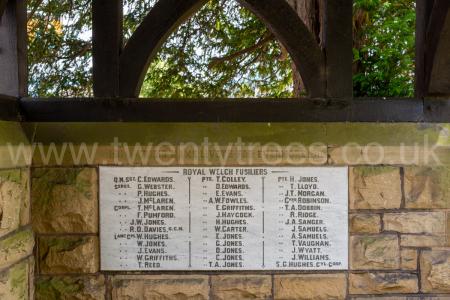
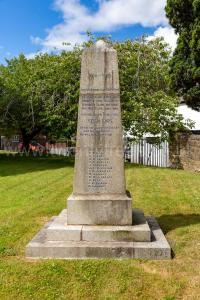
Europe, British Isles, North East Wales, Denbighshire, Ruabon, St Mary's Church, General Monuments
General Monuments to unknown person.
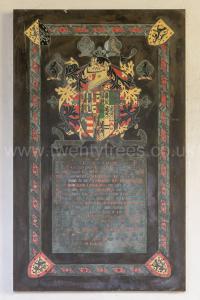
After 1712. Monument to Ellis Lloyd
Ellis Lloyd: On 01 Jul 1712 he died.
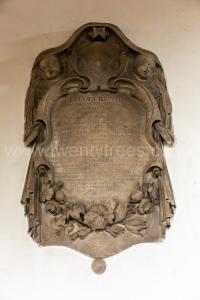
After 1760. Monument to Edward Lloyd of Plas Madoc (age 73).
Edward Lloyd of Plas Madoc: Around 1687 he was born. On 08 Aug 1760 he died.
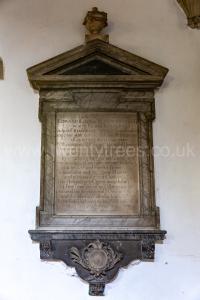
After 11 Aug 1763. Memorial to William Watkins William-Wynn (deceased).
William Watkins William-Wynn: On 19 Apr 1750 he was born to Watkin Williams-Wynn 3rd Baronet and Frances Shackerley Lady Williams-Wynn. He was born posthumously his father having died seven months previously. On 11 Aug 1763 William Watkins William-Wynn died.
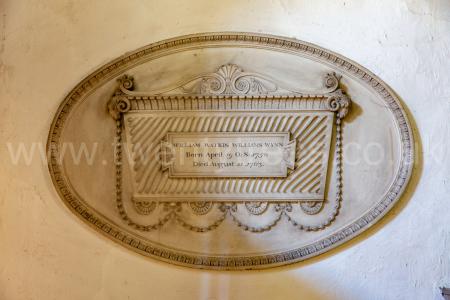
After 27 Dec 1807. Monument to Randle Jones of Bryn.
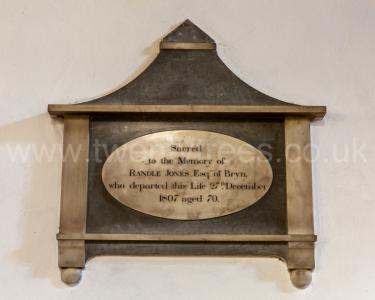
After 1815. Monument to Edward and Anne Rowland sculpted by Samuel and Thomas Francyes of Liverpool.
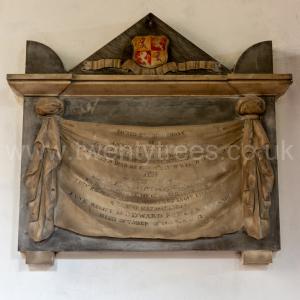
After 20 Jun 1823. Monument to Reverend Joseph Venables and Mary daughter of Edward Rowland.
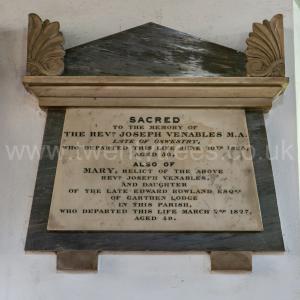
After 1824. Monument to John Jones of Ruabon Mills.
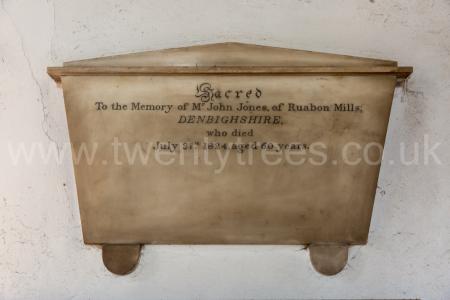
After 28 Jul 1828. Monument to Edward Lloyd Rowland (deceased)
Edward Lloyd Rowland: Around 1789 he was born. On 28 Jul 1828 he died.
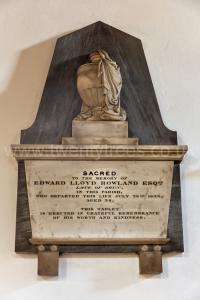
After 28 Mar 1856. Memorial to Henry Watkin Williams-Wynn (deceased) and Hester Frances Smith. Sculpted by Beford of Oxford Street.
Hester Frances Smith: Around 1790 she was born to Robert Smith 1st Baron Carrington. On 30 Sep 1813 Henry Watkin Williams-Wynn and she were married. On 05 Mar 1854 Hester Frances Smith died.
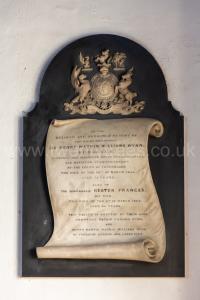
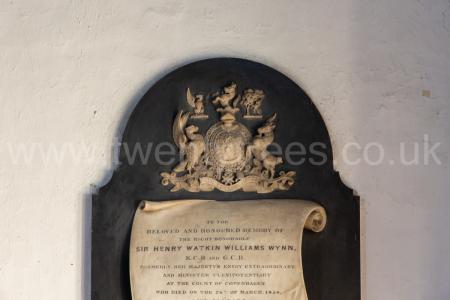
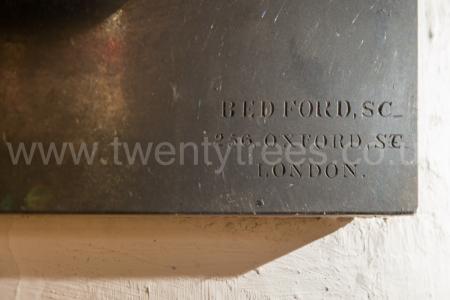
After 1900. Monument to Evan Morgan Roderick.
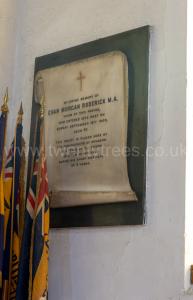
After 1902. Monument to Sergeant-Major Philip Murless.
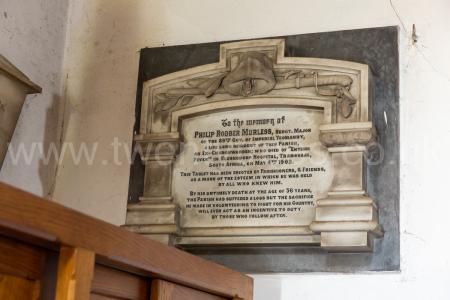
After 02 Jun 1903. Memorial to William Jones of Ty Newydd, Ruabon.
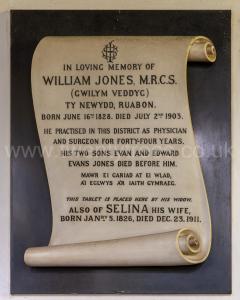
After Jan 1915. Memorial to Charles Taylor Captain of the Royal Navy. Killed in action January 1915 whilst serving on HMS Tiger during the Battle of Dogger Bank on which ten men were killed.
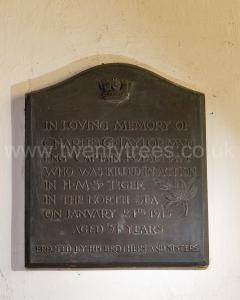
Europe, British Isles, North East Wales, Denbighshire, Ruabon, St Mary's Church, Monument to Charlotte Eva Edwards [Map]![]()
After 08 Feb 1889. Monument [Map] to Charlotte Eva Edwards wife of Ebenezer Wood Edwards Vicar of Ruabon from 1862 to 1897. Signed Gaffin & Co but Thomas Gaffin and his son Thomas Gaffin were both dead; it isn't clear who was running the company?
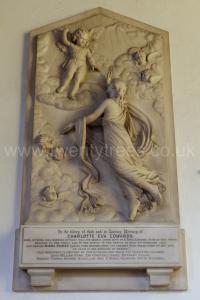
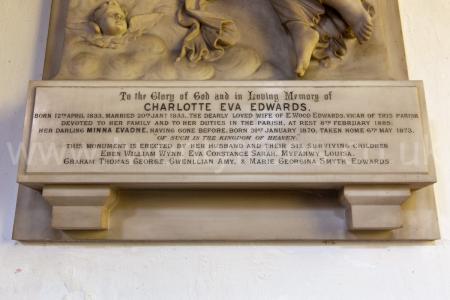
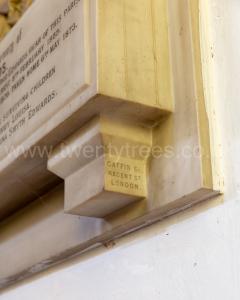
Europe, British Isles, North East Wales, Denbighshire, Ruabon, St Mary's Church, Monument to Edward Lloyd Kenyon [Map]![]()
After 09 Jul 1843. Monument [Map] to Edward Lloyd Kenyon sculpted by Edward Bowring Stephens (age 27).
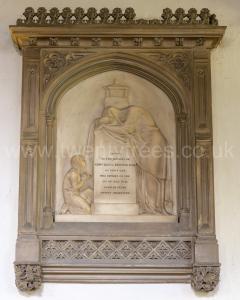
Europe, British Isles, North East Wales, Denbighshire, Ruabon, St Mary's Church, Monument to Henrietta Somerset [Map]![]()
After 1769. Monument [Map] to Henrietta Somerset Lady Williams-Wynn (age 20) sculpted by Joseph Nollekens (age 31).
She, Henrietta, died in 1769 fifteen weeks after she was married of unknown causes.
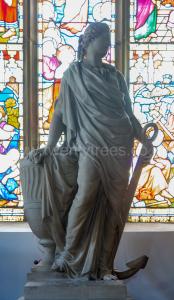
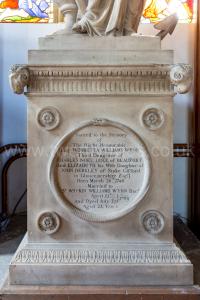
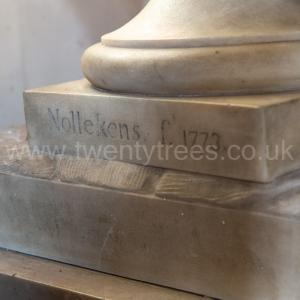
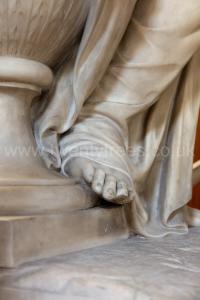
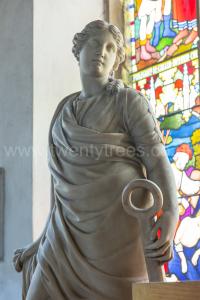
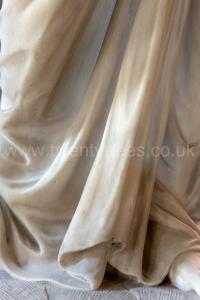
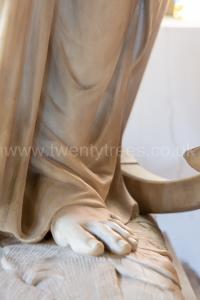
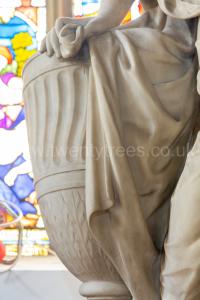
Europe, British Isles, North East Wales, Denbighshire, Ruabon, St Mary's Church, Monument to Henry [Map]![]()
After 1719. Monument [Map] to Henry Wynn of Rhiwgoch in Merionethshire and Jane Lloyd, and their son John Wynn 5th Baronet (age 91). Sculpted by Robert Wynne of Ruabon.
Henry Wynn of Rhiwgoch in Merionethshire: Around 1602 he was born to John Wynn 1st Baronet and Sidney Gerard. In or before 1628 Henry Wynn of Rhiwgoch in Merionethshire and Jane Lloyd were married. On 27 Jul 1671 Henry Wynn of Rhiwgoch in Merionethshire died.
Jane Lloyd: Around 1591 she was born to Ellis Lloyd of Rhiwgogh. In 1675 she died.
John Wynn 5th Baronet: In 1628 he was born to Henry Wynn of Rhiwgoch in Merionethshire and Jane Lloyd. On 11 Jan 1719 John Wynn 5th Baronet died without issue. Baronet Wynn of Gwydir extinct. He bequeathed his estates, the second or third largest in Wales, to his second-cousin once-removed Jane Thelwall, who had predeceased him, daughter of his great-aunt Sydney Wynn. By doing so the his estates and the Williams estates of her former husband William Williams-Wynn 2nd Baronet, also the second or third largest in Wales, were combined into the largest estate in Wales which far execeeded any other. At this time William Williams-Wynn 2nd Baronet changed his surname from Williams to Williams-Wynn.
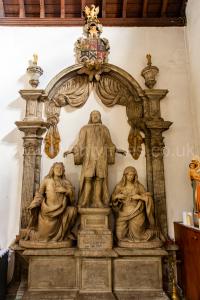
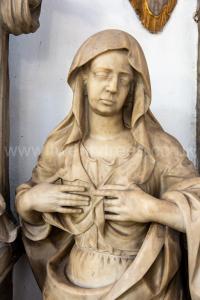
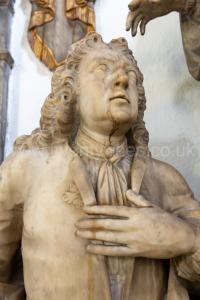
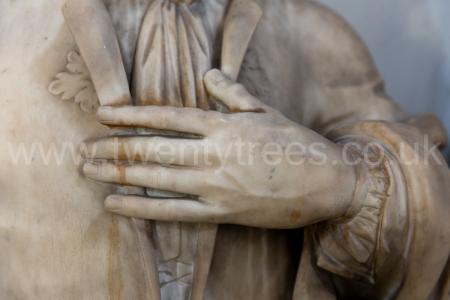
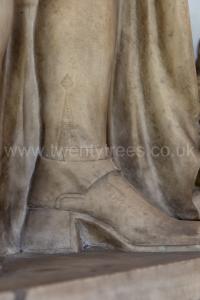
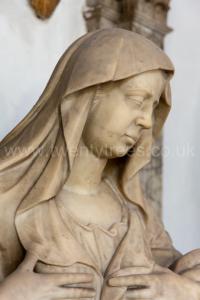
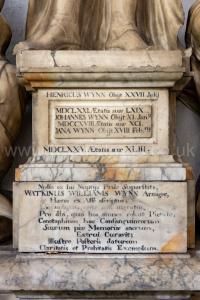
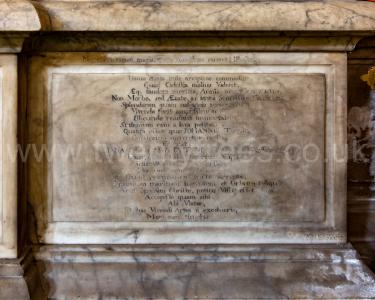
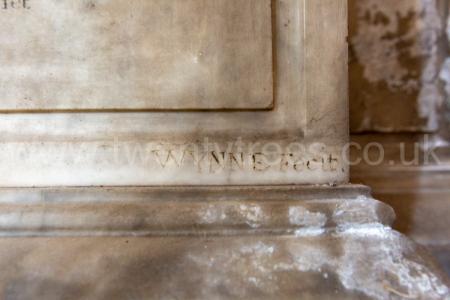
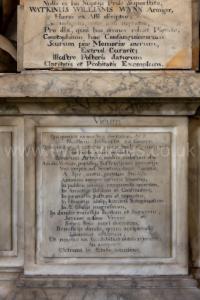

Europe, British Isles, North East Wales, Denbighshire, Ruabon, St Mary's Church, Monument to John Ap Ellis Eyton [Map]![]()
In or after 1526. St Mary's Church, Ruabon [Map]. Monument [Map] to John ap Ellis Eyton. Alabaster Monument. Lancastrian Esses Collar. Possibly Harpur and Moorecock of Burton on Trent.
John ap Ellis Eyton: In 1526 he died.

 Chest with Angels with Rounded Wings holding Shields indicative of Harpur and Moorecock of Burton on Trent.
Chest with Angels with Rounded Wings holding Shields indicative of Harpur and Moorecock of Burton on Trent.
 Detail of his head. Categorised as Fluted Period. Note the absence of headwear, his being clean shaven and the Standard protecting the neck all of which define the Fluted Period.
Detail of his head. Categorised as Fluted Period. Note the absence of headwear, his being clean shaven and the Standard protecting the neck all of which define the Fluted Period.
 Before it was damaged this was a dog chewing at the hem of her dress; also indicative of Harpur and Moorecock of Burton on Trent.
Before it was damaged this was a dog chewing at the hem of her dress; also indicative of Harpur and Moorecock of Burton on Trent.



 She wearing a Gabled Headress.
She wearing a Gabled Headress.
 Tudor Roses on his sword pommel.
Tudor Roses on his sword pommel.
 Bedesman and Swirling Tail both indicative of Harpur and Moorecock of Burton on Trent.
Bedesman and Swirling Tail both indicative of Harpur and Moorecock of Burton on Trent.
 A curious lion at his feet. Unlikely the carver had ever seen a lion.
A curious lion at his feet. Unlikely the carver had ever seen a lion.


 Detail of the orle, mantling and what remains of the crest on his Great Helm. Difficult to tell what it was originally.
Detail of the orle, mantling and what remains of the crest on his Great Helm. Difficult to tell what it was originally.





Europe, British Isles, North East Wales, Denbighshire, Ruabon, St Mary's Church, Monument to Watkin Williams-Wynn 3rd Baronet [Map]![]()
1755. Monument [Map] to Watkin Williams-Wynn 3rd Baronet.
His widow Lady Frances (age 34) chose Michael Rysbrack (age 60) to erect her husband's monument in the classical style. The Agreement was made on the 21 March 1750 and cost £485. The long Latin inscription was composed by William King (age 69), principal of St Mary's Hall, Oxford.
The size of the monument created a problem. A Faculty was granted to Lady Frances (age 34), in 1753, to add a chapel at the south east end of the church, adjacent to the chancel "… to make erect and build a handsome convenient Isle or building… in order to erect monuments seats and pews therein and making a burying vault underneath the same or otherwise to apply the same to Godly purposes" .The work was carried out in 1755.
Frances Shackerley Lady Williams-Wynn: In 1721 she was born to George Shackerley of Hulme and Anne Bagot. In Jul 1748 Watkin Williams-Wynn 3rd Baronet and she were married. She was his god-daughter. The difference in their ages was 29 years. In 1803 she died.
William King: On 16 Mar 1685 he was born to Reverend Peregrine King and Margaret Smyth. On 30 Dec 1763 he died.
